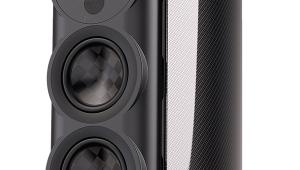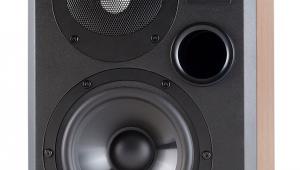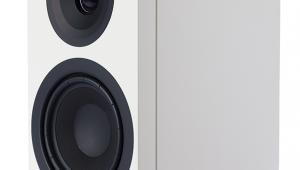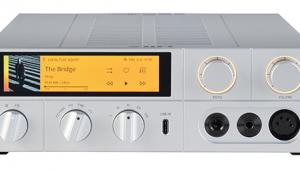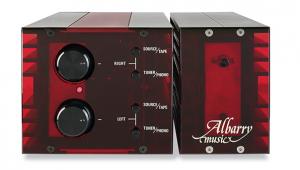Lumen White Silver Flame (£25,000)
The use of ceramic materials in loudspeaker diaphragms can’t be described as novel because every anodised aluminium cone or dome has a surface layer of alumina (aluminium oxide), allowing it to be described as a ceramic-metal sandwich or similar – as at least one speaker manufacturer has indeed done. But pure ceramic diaphragms are a rarity, and loudspeakers that use them exclusively, as the Lumen White Silver Flame does, are rarer still. All five drivers in this arresting-looking three-way design have white ceramic diaphragms in the form of everted (concave) domes. As explained in the box-out, the attraction of a ceramic diaphragm material is that it can be lighter and stiffer than common metal equivalents, which promises higher bending wave velocity and hence higher breakup frequency for a given diaphragm size and shape. The manufacturer of the Silver Flame’s drivers (Thiel Accuton in Germany, www.accuton.de) also claims that the material provides high internal damping, to help quell those diaphragm resonances when they occur.
A downside of ceramic diaphragms is that – like a bone china tea service – they are brittle and so prone to accidental damage from even a slight accidental knock. Hence all five of the Silver Flame’s drive units (three 178mm bass drivers, one 140mm midrange unit and a 25mm tweeter) are fitted with protective metal grilles; this is something I’ve been cautious of ever since, many years ago, the late Richard Heyser demonstrated in a review of the Yamaha NS1000 in Audio magazine that they can have a deleterious effect on a speaker’s energy storage. Indeed, the grille covering the Silver Flame’s midrange driver rings very clearly if you flick it with a finger, and the bass unit grilles ring too, albeit less clearly. In a speaker where so much effort and expense has been devoted to controlling cabinet and diaphragm resonance, this seems – at the very least – incongruous.
EYE-CATCHING
Apart from its pure white driver diaphragms the Silver Flame’s most eye-catching feature is its large, curvaceous ‘instrument grade’ cabinet. All of 1.15m tall, it’s heavy too at 52kg. A ‘plywood compound construction’ with no MDF content and no damping of the enclosed air, in horizontal cross-section it is almost teardrop-shaped, albeit truncated at the thin end to form a narrow rear panel and again at the thick end to form a flat front baffle. This welcome departure from the familiar rectangular box cabinet should provide numerous benefits: increased side panel stiffness, suppression of internal air resonance modes and reduced diffraction effects from the front baffle edges.
The review pair were finished in a metallic silver paint which, while eye-catching and appropriate, is only likely to suit the sort of modern, minimalist decors beloved of product brochure art directors. No matter: the Silver Flame is also available in ivory or piano black finishes. There is no additional grille with which to hide the drivers from view.
You might expect a three-way speaker of this class to have a fully split crossover, with three pairs of input terminals at the rear, allowing separate access to the low-pass, bandpass and high-pass sections of the network. But any chance of bi-wiring/amping or tri-wiring/amping the Silver Flame is removed by it having a single set of terminals, albeit classy WBT items. This is clearly a very deliberate choice by the Lumen White design team, but one which some potential owners will surely find frustrating.
The shape of the cabinet effectively dictates that three spikes be fitted to the base rather than four but, as every old-school milkmaid knows, that’s the optimum number anyway. Metal cone ‘feet’ house the spikes at either side of the front baffle, while a single plain but larger diameter spike is used at the rear. As this is shorter than the front spikes, the cabinet is tilted backwards slightly, presumably to fine-tune time-alignment between the midrange driver (positioned at about seated ear height) and the tweeter (which is above it).
By the way: although it is far from immediately obvious, the Silver Flame is reflex-loaded in the bass, the port not being the familiar tube that exhausts the front or rear panel but two narrow slits in the sculpted rear of the cabinet, above the input terminals.
SEAMLESS
If I had to choose just one word to express what makes the Silver Flames special, it would be seamlessness. Get them set up correctly (I toed them out slightly from pointing straight at the listening position) and they do a remarkable job of disguising the fact that each has five drivers operating over three frequency ranges – even though, at a listening distance of about 3m, I was aware that I was listening to physically dispersed sources rather than point sources of sound.
Although Lumen White says little about the crossover design save that it is minimalist and takes account of resonance and field-coupling effects within the network, it is unusually effective at melding the output of the multiple drivers into a coherent whole. Nowhere is this more obvious than in the Silver Flame’s majestic reproduction of the dynamic scale and timbral subtlety of a large symphony orchestra. One of my favourite orchestral recordings – the 24/96 DVD version of Rachmaninov’s Symphonic Dances performed by the Dallas Symphony under the baton of Donald Johanos [Classic Records DAD 1004] – was rendered better than I have ever heard it before, combining riveting dynamic snap and punch with the delicate touch necessary to do full justice to the tone colours of the spot-lit woodwind. This is a compelling performance in any case but through the Silver Flames it was utterly unputdownable.
While we’re talking big and (a little) brash, they also did an unusually fine job of recreating the buzz of live performance that does more than compensate for the rough edges of ‘Double Trouble’ from Eric Clapton’s Just One Night (Polydor 531 827-2). You know within seconds of this track starting – while the Budokan Theatre audience shouts and whistles and the band shapes up to play – whether a speaker is going to do it justice or not. The soundstage should be big, the bass line well controlled, Clapton’s guitar sound authentically rough-edged, and his voice – well, his skilful vocal delivery should impress as much as his guitar playing (it was this track that first alerted me to the fact that Slowhand really can sing). The Silver Flames did all these things and, importantly, wrapped them up into a credible, satisfying whole where hi-fi was subservient to the music.
LESS CAN BE MORE
Smaller-scale music fared just as well. A sentimentally important recording for me, Popular Music from the Time of Henry VIII was originally released as an LP by Saga Records and, like rather too much of that company’s output, my pressing – bought post-concert at the back of a Bayswater church – was crappy. But the fine performance of the Hilliard Ensemble, before anyone had heard of them, turned me on to the delights of early music, while John Shuttleworth’s recording – almost certainly made using a crossed-pair mic technique – was an excellent demonstration of how, in the hands of the right recording engineer, less is more.
I dearly wish that somebody would transcribe the analogue master to hi-res PCM but for the moment the now-deleted CD release serves as a good reminder of why the original LP so excited me. The excellent singing of the Hilliards, the exotic tone colours of the instrumental pieces, the spacious, naturally dimensioned recording and the intriguing variety of songs, from the wistful miniature of ‘O My Heart is Sore’ to the lusty agricultural parts catalogue that is ‘The Pleugh Song’, were all marvellously evoked by the Silver Flames.
You’ll have gathered from the foregoing that this is an unusually fine loudspeaker, one which I have thoroughly enjoyed having in my home for its too brief stay. Which brings us to the one thorny issue: price. Can a loudspeaker like this ever be worth £25k a pair? Discuss. Of course, the answer is highly subjective, and probably not uncorrelated with the depth of one’s pockets. I will just say this: were the asking price half the current figure I’d be cupping my hands round my mouth to shout to the audiophile world, ‘This you have to hear’. As it is, the high cost of joining the Silver Flame owner’s club tempers my enthusiasm a little.
VERDICT
This large, heavy, costly speaker is intriguing to look at and a delight to listen to. The unusual cabinet form clearly does a fine job of suppressing structural and enclosed air resonances, while the five ceramic-diaphragm drive units are seamlessly integrated to deliver high resolution, dynamic sound that always serves the music, whether large-scale or small-scale. All told: a pricey but classy product.
Sound Quality: 89%
Originally published in the January 2010 issue



